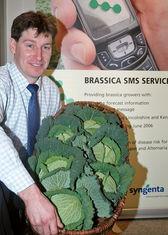
The Alium and Brassica Centre (ABC) has reported that this year’s difficult growing season is set to become even worse, with high levels of leaf disease emerging earlier than usual this year.
Localised pockets of Ringspot, Light Leaf Spot and Phoma are beginning to become visible, but, according to the ABC, Xanthomomas has already been identified, with the major potential to cause real problems in the months ahead.
The infection caused significant losses in marketable yield last autumn, with cabbage and late autumn cauliflower. Andy Richardson of ABC said that he aims to combat this season’s impending problem through improved control of Ringspot, Altemaria and Phoma, which seem to make plants more susceptible to it.
He added that Light Leaf Spot, which has hitherto only been a real problem in Scotland, has found its way as far south as Lincolnshire due to the wet conditions and increase in oilseed rape cultivation. He advised growers to treat it with a strobilurin/triazole mix.
“Wet soil conditions have put plantlings well behind normal, and continuity of supply is going to be a huge issue for the brassica supply chain,” he said.
“Although fungicides have no direct effect on the bacteria, our experience with Amistar Top in trials is that the enhanced control of leaf fungal diseases has a significant effect on reducing the damage from Xanthomonas,” he added. The higher level of difenoconazole in the Amistar Top mix, compared to straight Plover, gives a greater degree of curative activity and longer lasting protection against Ringspot, Alternaria and Phoma.
“We are seeing a far higher incidence of Phoma infection every year, with the risk of early and intensive attacks predicted this season,” he adds. Wet soils and morning dew could be sufficient to trigger Phoma spore release from the high level of stem cankers on recently harvested oilseed rape stubbles.



